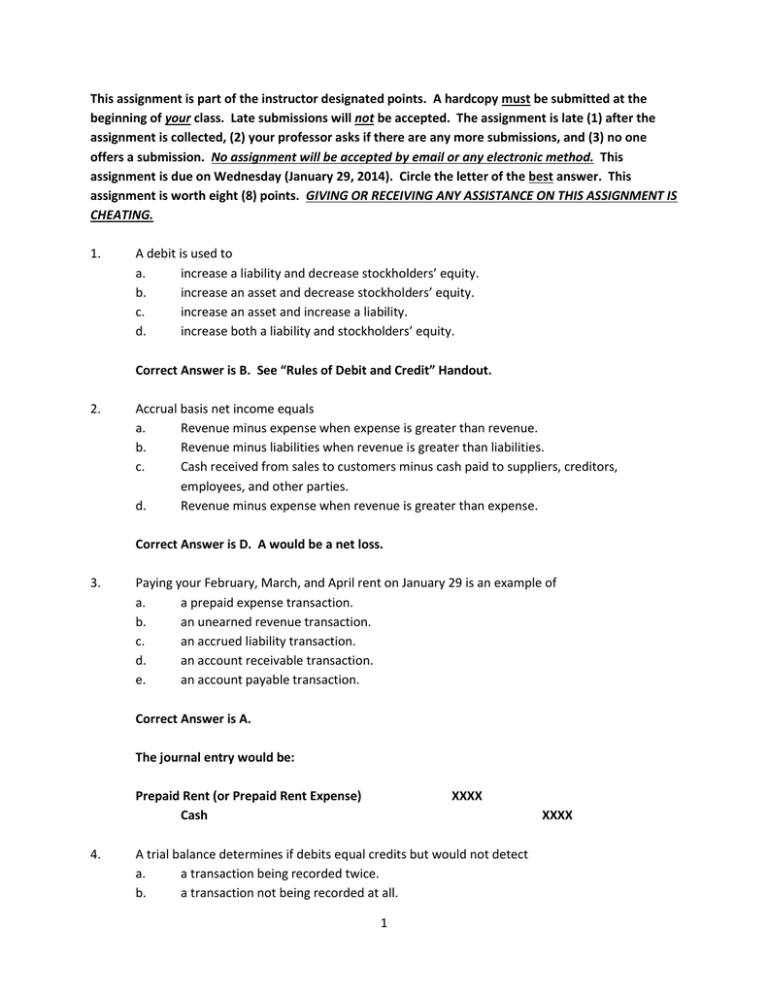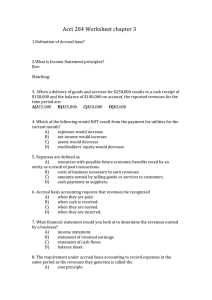This assignment is part of the instructor designated points. A
advertisement

This assignment is part of the instructor designated points. A hardcopy must be submitted at the beginning of your class. Late submissions will not be accepted. The assignment is late (1) after the assignment is collected, (2) your professor asks if there are any more submissions, and (3) no one offers a submission. No assignment will be accepted by email or any electronic method. This assignment is due on Wednesday (January 29, 2014). Circle the letter of the best answer. This assignment is worth eight (8) points. GIVING OR RECEIVING ANY ASSISTANCE ON THIS ASSIGNMENT IS CHEATING. 1. A debit is used to a. increase a liability and decrease stockholders’ equity. b. increase an asset and decrease stockholders’ equity. c. increase an asset and increase a liability. d. increase both a liability and stockholders’ equity. Correct Answer is B. See “Rules of Debit and Credit” Handout. 2. Accrual basis net income equals a. Revenue minus expense when expense is greater than revenue. b. Revenue minus liabilities when revenue is greater than liabilities. c. Cash received from sales to customers minus cash paid to suppliers, creditors, employees, and other parties. d. Revenue minus expense when revenue is greater than expense. Correct Answer is D. A would be a net loss. 3. Paying your February, March, and April rent on January 29 is an example of a. a prepaid expense transaction. b. an unearned revenue transaction. c. an accrued liability transaction. d. an account receivable transaction. e. an account payable transaction. Correct Answer is A. The journal entry would be: Prepaid Rent (or Prepaid Rent Expense) Cash 4. XXXX XXXX A trial balance determines if debits equal credits but would not detect a. a transaction being recorded twice. b. a transaction not being recorded at all. 1 c. d. 5. an amount entered into the wrong account. all of the above. Correct Answer is D. If the ending balance in accounts receivable is less than the beginning balance in accounts receivable and no accounts were determined to be worthless a. cash collections during the period were greater than the amount of revenue earned. b. no cash was collected during the period. c. no sales were made during the period. d. cash collections during the period were less than the amount of revenue earned. Correct Answer is A. When cash is collected from previous credit sales the following entry decreases accounts receivable: Cash XXXX Accounts Receivable XXXX When sales are made on account, accounts receivable is increased as follows: Accounts Receivable Sales (Sales Revenue) XXXX XXXX If ending Accounts Receivable is less than beginning accounts receivable then cash collected must have been greater than sales (sales revenue). 6. For 2013, DMG Corporation reported an increase of $400,000 in assets, an increase in liabilities of $200,000, dividends of $50,000, revenues of $1,000,000 and no change in contributed capital. What is the amount of DMG’s expenses for 2013? a. $750,000. b. $200,000. c. $950,000. d. $800,000. Correct Answer is A. Assets = Liabilities + Stockholders’ Equity +400,000 = +200,000 + 1,000,000 (revenues) – X (expenses) – 50,000 (dividends) +400,000 – 200,000 – 1,000,000 +50,000 = - X (expenses) 2 -750,000 = -X(expenses) 7. Which of the following accounts has a normal credit balance? a. Prepaid rent. b. Accounts receivable. c. Unearned revenue. d. Dividends. Correct Answer is C. Unearned revenue is a liability account. 8. DMG’s dog walking company walks 100 dogs a week. The company was paid in January for services that will be provided in February. DMG uses the accrual basis of accounting. Which one of the following statements is false? a. The February income statement shows the effects of the January transaction. b. The January balance sheet shows the effects of the January transaction. c. The January income statement shows the effects of the January transaction. d. The January statement of cash flows shows the effects of the January transaction. Correct answer is C. The journal entry in January would be: Cash XXXX Unearned Revenue XXXX Both cash and unearned revenue are balance sheet accounts. Therefore they will appear on the January balance sheet. The cash inflow will appear on the January statement of cash flows. The January income statement is not affected by this transaction. The journal entry in February would be: Unearned Revenue Revenue XXXX XXXX Therefore the February income statement shows the effects of the January transaction. A is true. The revenue is earned in February when the service is provided. Therefore it will appear on the February income statement. B is true. The cash and unearned revenue will appear on the January balance sheet. 3 C is false. The cash is received in January but not earned until February. Accrual basis accounting requires revenue be recognized (recorded) when earned, not when the cash is received. D is true. The receipt of cash from customers in January will appear on the January statement of cash flows. 9. ACCT2010 Company reported net income of $190,000 for 2013 and a net profit margin of 20%. What was ACCT2010’s total revenue? a. $950,000. b. $ 38,000. c. $190,000. d. $800,000. Correct answer is A. Net Profit Margin = Net Income/Total Revenue .2 = $190,000/X .2 X = $190,000 X = $190,000/.2 = $950,000 10. ACCT2010 Company orders goods in January, receives them in February, pays for them in March, sells them to customers in April, and is paid by the customers in May. Using accrual basis of accounting a. expenses are recorded (recognized) in April and revenues are recorded (recognized) in April. b. expenses are recorded (recognized) in April and revenues are recorded (recognized) in May. c. expenses are recorded (recognized) in March and revenues are recorded (recognized) in May. d. expenses are recorded (recognized) in February and revenues are recorded (recognized) in April. Correct Answer is A. Accrual basis accounting requires that revenue be recognized (recorded) when earned. That is when the good or service has been provided to the customer. In April the customers received the goods. Accrual basis accounting requires the matching of expenses to revenue whenever possible. You use up a good when it was sold. The goods used 4 up in April means the expense has been incurred (it has happened). Therefore the expense is recognized (recorded) in April. 11. Which of the following is a true statement about the matching principle? a. The matching principle states that expenses should be recognized when cash is paid for them. b. The matching principle states that assets must match, or equal, liabilities plus stockholders’ equity. c. The matching principle states that expenses should be recognized in the same period as the associated revenues are earned. d. The matching principle states that expenses must equal revenues each accounting period after adjustments. Correct Answer is C. See explanation for 10 above. 12. ACCT2010 Company received $120,000 in December 2013 for rent of a building for all of 2014. How much revenue should appear on the income statement for the first quarter (three months) of 2014? a. $10,000. b. $20,000. c. $30,000. d. $120,000. e. $0. Correct Answer is C. Rent revenue is earned when someone has used whatever we rented to them. At the end of the first quarter three months of rent have been earned. The rent is $10,000 per month ($120,000/12 = $10,000). 3 X $10,000 = $30,000. 5





